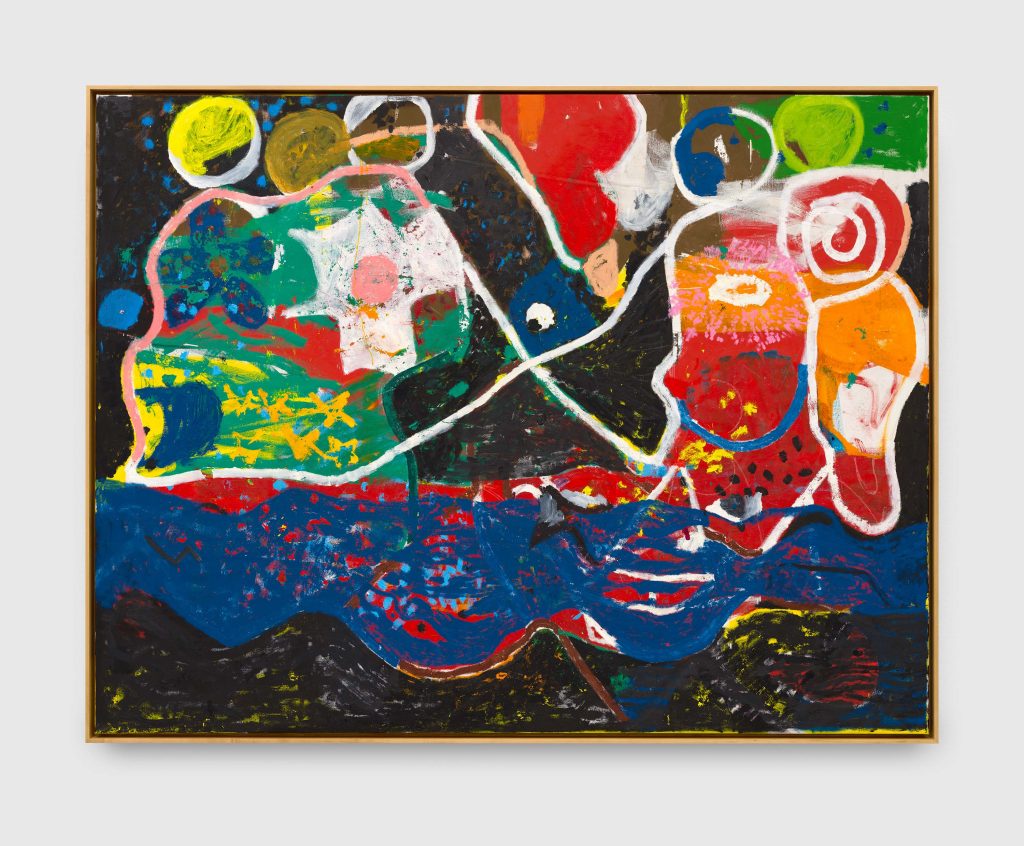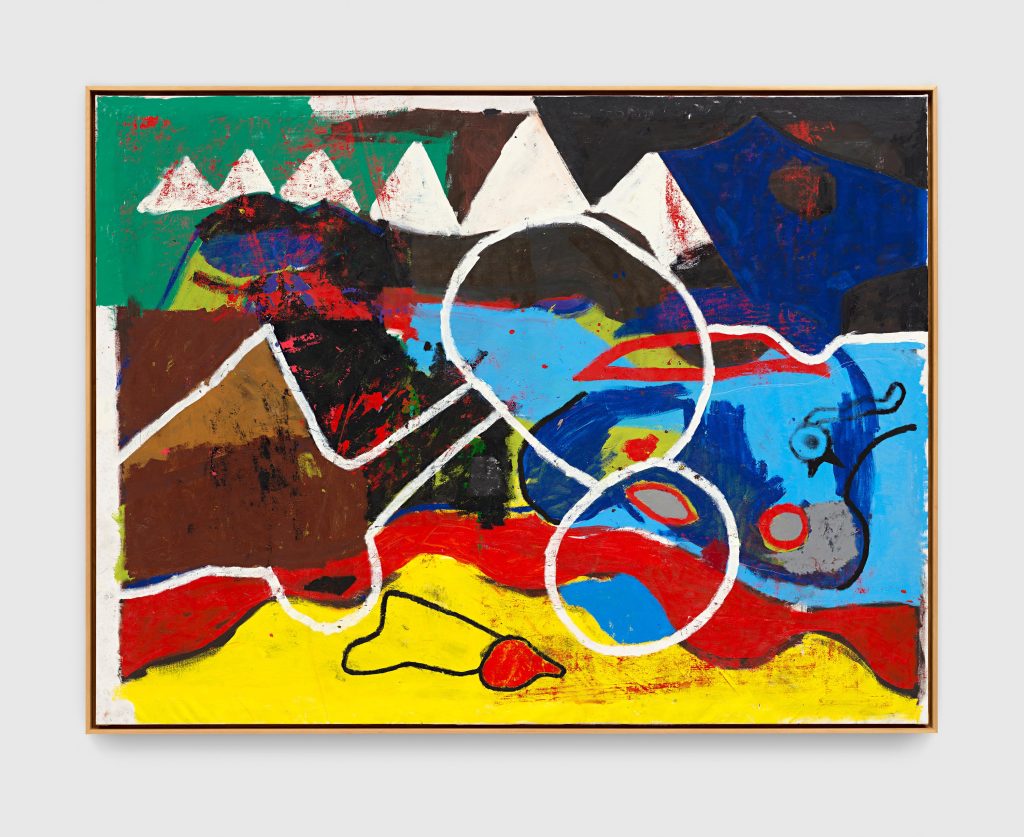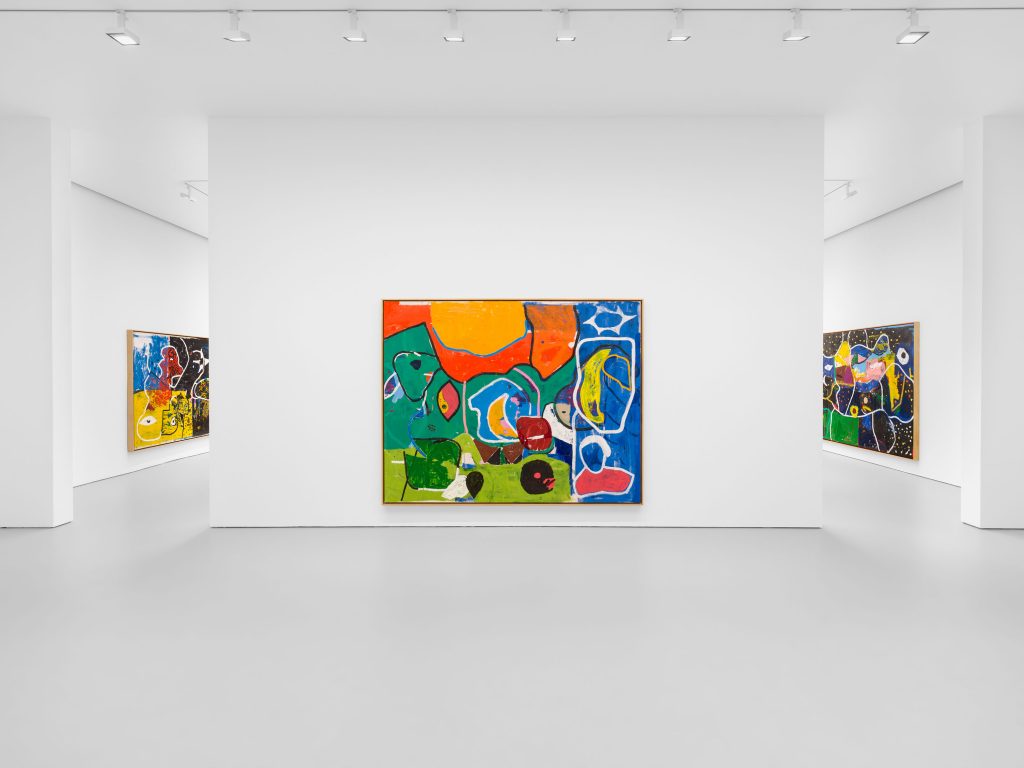“Occident” (2023-2024), an oil-on-canvas work by New York artist Joe Bradley, has pleasantly lingered in the back of my mind for weeks. It’s part of the artist’s debut solo exhibition with David Zwirner in New York City’s Chelsea neighborhood: “Vom Abend,” which is scheduled to run through May 18.
Starting with this piece individually, it’s very large, easily nearing nine and a half feet in width. Bradley’s oil paints are often — including here — applied so the coverage isn’t quite total, which helps, for one, with more easily seeing layers of color that lie beneath. That method of application brings the rolling but coarse textures of the oil paint into more central view, as you’re confronted with both the overall image and inherent qualities of the materials that Bradley spotlights.
A Flowing Presentation of Color
The paintings in “Vom Abend” smoothly shift between polarities, as though the exhibition’s contents as a whole are somehow breathing in unison. Line, form, color, and other elements surge and retract like components of a psychological sea. Contrasting with effectively total abstraction, there are perceptible references at times to real-world images like faces or bodies, but Bradley smoothly melds these into swathes of enveloping color and other elements suggestive of transcendence rather than physical perfection.
In general, there’s a lot of artfully imperfect curvature and unifying surges in visual rhythm that exist only for a moment. You might pick up on an impactful visual turn, but it’ll ultimately just snake into the looming background ether rather than defining the whole piece. It’s striking beauty from insistent discord, as the collective impacts of each painting soar past any sense of simple chaos.
For one, the textures from Bradley’s vast interminglings of oil paint steep everything in a kind of lovely inward meld, as though the images’ sub-structures are blending into each other — both there and not, simultaneously.
It’s not just material, though. Bradley ultimately holds the visual rhythms of these pieces at a perfectly communicative level in which many elements can shine but little if anything feels like it dominates the scene. Instead, everything moves, and the tone of the wide-ranging components of this work sits nicely somewhere that’s uneasy yet forcefully present.
Disparate Cohesion
There’s so much going on in some of these images across “Vom Abend” that you really might not expect it, but the impression is more like a unified lightning flash than a hailstorm of ideas. “Easy Death” (2023-2024), for instance, sports large outlines of shapes both curved and angular, insisting on an elevating middle ground.
Speaking of specifics, what really grabbed me about “Occident” was initially something very specific: Bradley’s layering of black oil paint, through which colors painted underneath remain visible and alongside which there’s a somewhat dark blue layered atop rich, passionate red.
The color palette, combined with some of those other threads, suggested a quiet moment of collapse captured with glaring precision.
I’m fascinated by normally bustling sites that, through whatever course of events, suddenly are found empty, and that’s where my thinking went with this. The red and blue — combining common primary colors operating at tonal opposites — suggested an even balance like movement, forward motion, and/or the like, or at least the expectation and/or opportunity for that kind of thing. But that lingering mind-pier of possibility was put in immediate juxtaposition with clouds of black — averting the scene from its perhaps original course with a forceful pull.
Round shapes formed by white lines keep the scene energized and arguably pull back from the full crash that the black and other elements might suggest — and ultimately, that’s a lot of what transpires across this entire exhibition from Bradley: a back-and-forth dance across scenes that you might expect to implode but instead linger, solidified in moments of transition. Time, falling in on itself.

Evoking the Real… Almost
Bradley repeatedly adds layers of black oil paint across the works in this exhibition, including “Kalparush” (2023-2024), which somehow managed to remind me of landscapes as my eye felt drawn towards a patch of light blue in the upper portion that’ll make you start thinking of horizons.
But this hypothetical horizon is held somewhat at a distance, as though — in this imagining — you’re looking out at it from the inside of a mind-cave, blending the mind’s free-form menagerie that somehow works to keep us going in life with little bits and pieces of something that’s suggestive of the external, physical world.
I’d call a lot of the forms (or senses of form) here and in other works relatively moderate in size: enough to make a resounding impact while still requiring a lot more to actually approach the edge of the painting, as though Bradley is unearthing a layer of evocative unrest.
The undercurrent through a lot I saw made me imagine a broken down amusement park. The painted images feel sharp, bold, and inviting — dream-like scenes where the bold-faced progressions come across as familiar before you venture further and find clouds of decay lifting the previous scenery from its hinges and swirling everything like a tornado.
Apart from such a metaphor, you get the sense when looking at these paintings that Bradley put down these paints without much tension, leaning instead into free-flowing patterns that pleasantly connect when you’re looking at one component after the next, even if the overall images clearly diverge from strict order. The paintings suggest insistent flow, and in their compositional suggestions of human form and the like, it’s interesting to consider how what we know as our physical processes can find an analogue in our psyches. Bradley touches on the insistent chaos of the human body and attendant experiences of it: searing certainty arising from a tangled jumble.


Find more information about “Joe Bradley: Vom Abend” at David Zwirner right here.
Featured image: Installation view, “Joe Bradley: Vom Abend,” David Zwirner, New York, April 11–May 18, 2024; Courtesy David Zwirner
You may also like
-
Diana Kurz at Lincoln Glenn in New York: A Review of a Shining Art Exhibition
-
Dustin Hodges at 15 Orient in New York City: An Ensnaring Exhibition at an Exciting Gallery
-
Maren Hassinger at Susan Inglett Gallery in New York: Reviewing an Uplifting Art Exhibition
-
Enzo Shalom at Bortolami in New York City: Reviewing an Entrancing Exhibition of Paintings
-
“Ben Werther: Townworld” at Amanita in New York City: Reviewing a Richly Memorable Art Exhibition
